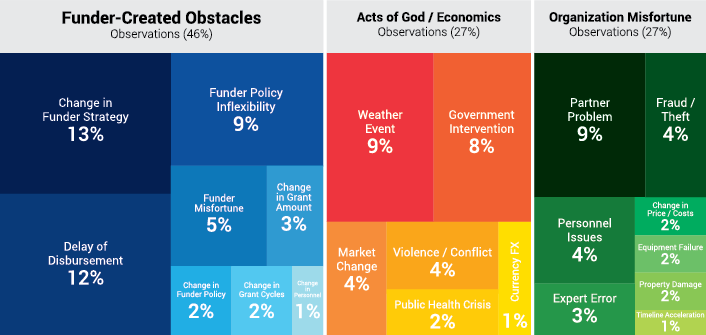“What Goes Wrong” in Impact-Focused Projects?: Uncovering roadblocks

Roadblock Analysis Report, by Open Road Alliance, has found that funders are contributing to disruptions to project implementation and therefore threatening the impact of their own investments.
“The implications of this analysis are sobering, because this data suggests that the biggest barrier to effective impact and the greatest pain point for nonprofits and social enterprises are their own funders,” notes the report. “We have become our own enemy in the pursuit of impact and return on investment.”
As Fast Company states, entrenched levels of bureaucracy seem to be the main culprit: “[E]fforts to professionalize our own work through increased policy and procedure and efforts to ensure fiscal accountability through restricted grants have unintended, harmful consequences that we now are seeing.”
Only 20% of grants made in the U.S. are unrestricted, meaning most come with earmarks for where and how the money can be used, along with a timetable for when the money is released. It’s a funder-dictated relationship, and often one-sided, because groups that are reliant on funding don’t want to express dislike for some terms, lest they upset those doling out the cash.
Grantmakers in the Arts defines capitalization as “the accumulation of the resources an organization needs to fulfill its mission over time,” specifically with regard to financial health. In response to the observation that it has been the norm for the nonprofit arts sector to be poorly capitalized, an issue which disproportionately affects ALAANA organizations, GIA embarked on the National Capitalization Project (NCP) in 2010. Part of GIA’s position on healthy capitalization of organizations includes general operating support as one approach to lessening roadblocks in arts philanthropy.
Rebecca Thomas, vice president of Nonprofit Finance Fund and partner in GIA’s Capitalization and Community workshops notes, “Capitalization has always been a loaded topic in the arts sector and beyond: it raises important questions about who we do and do not fund, exposing uncomfortable realities about equity in grantmaking.”
Read here the article in Fast Company.
Image: Open Road Alliance
